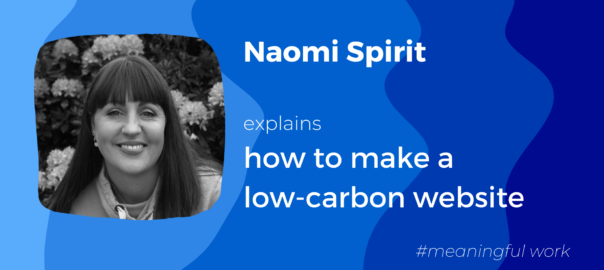In Meaningful work interviews I talk to people about their area of work and expertise to better understand what they do and why it matters to them.
Naomi Spirit is a founder of a small digital agency From This Day. They focus on creating websites with a low environmental impact. We discussed how to develop a low carbon website in terms of technology choices and user experience (UX).
How did you get started with the idea of creating an environment-focused digital agency?
We were looking to orientate towards meaningful work, to help people doing charity or ethical projects. When we’re doing work for people doing good things themselves, it’s almost like you’re doing the good work yourself. With our support, they’re making even more impact with their work.
Around 2017 when the IPCC Climate Report came out, I just felt so motivated that I had to do something to help the environment. I decided to start a blog to promote ways we could all be greener. So I used my development skills to create Little Green Ways. It has achieved a good reach throughout the years. We even started doing a bit of activism from it, including a petition about microplastics which gained quite a bit of traction and got discussed in a parliament.
I reached a point where I was deciding between moving to environmental work full time and not being a web developer anymore. Around that time, I became aware of the impact of our digital lives on the environment and the amount of co2 that we produce. I realised I could try and use my technical skills for good.
The Internet alone produces more carbon than the UK and I realised that maybe my specialist niche could help with that. While websites are a small part of the whole Internet, it’s still an area where I think I can do my bit. I can help educate other people to understand it better, create better websites that pollute less, and develop this as a specialist skill.
That’s how we shifted toward building super low carbon websites. Our new websites create about half a gram of carbon per page load. In contrast, we were looking at anywhere between four and 10 grams of carbon potential before. We’ve reduced the effect of any new site that we’re building. We have used our skills to ensure that you can still have a beautiful site even if it is low carbon, that’s where artistry comes in for example – www.arranecosavvy.org.uk – which still looks great even though it’s creating much less carbon. Restriction can actually improve design as you have to think outside the box.
What’s a low-carb website, and how do you think about the whole process?
Websites are usually served from servers that are not particularly environmentally friendly. There’s also a lot of infrastructure for information to get through to the device requesting that information from the server. Your end device also uses power to display the information. So you need to break this whole process down into many different areas to see where you can improve things.
The first thing to do is to make sure you have green hosting. We use Kualo and find them fantastic. They consider themselves a carbon-positive company. That is based on carbon offsetting. We realize that’s not the answer for everything, and we still need to reduce what we’re using too.
In terms of the website, it comes down to optimizing it to be as slick as possible. Use as few images as possible, reuse them, and use SVGs where possible. Compress the assets and build the theme light. Try not to use fancy fonts, keeping it plain where possible.
Another thing to consider is also your content structure. If you have a good User Experience, there’s less need to click around the site, which downloads extra assets, and increases server usage. It’s also worth considering a good archive policy and only keeping content if it will add value in the future to your actual website or SEO.
If you design a website with a dark design, it draws less power on the user’s device. So really, it’s just about being considerate about everything you’re doing. Doing things of value and just keeping everything as light as possible.
How can I think about my carbon footprint in the Cloud?
As an example, sharing your video on a Zoom call is carbon-heavy. If you’ve got a zoom call with 100 people sitting there all with video on it is creating a lot of carbon. There has to be a bit of awareness around how we work digitally with each other. I think the same with basically any green stuff – we can try and do things more sustainably. But the real green thing is to reduce what we’re doing, switch off a little bit, use less of everything.
There’s a great book by Gerry McGovern – World Wide Waste and a video talk that details lots of detail about how much carbon our digital lives uses. For example, a Kindle becomes more environmentally friendly than a paper books only after reading around 150 books.
What are some valuable resources and practices that you can recommend?
Website Carbon calculates how much carbon your website is using.
We are planting trees to offset the carbon usage of our projects and lifestyles. I can recommend Trees for Life and Ecologi.
Join 1% for the Planet Impact Pledge to support environmental initiatives.
What I learned from talking with Naomi
There are actual tests and metrics that I can use to evaluate the CO2 usage of web products that I work on.
Digital is still using energy, even if I don’t see it.
It’s a topic that not enough people around me are talking about yet. Something to look more into.
